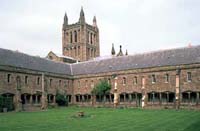| |
 |
Hereford Hereford Cathedral |
Hereford became a bishop's see in the late 7th century, although little is known of the Anglo-Saxon cathedral. The Norman cathedral, of which a good deal survives, was begun under Bishop Reynelm (1107 - 1115) and completed by c. 1148. Built of the local pink sandstone, it had three apses at the east end of the chancel which is of three bays and aisled. The existing chancel arcade and gallery are Norman, but the clerestory is 13th century. The tympana of the gallery bear carved geometrical relief in a style also seen in Peterborough cathedral. Originally there were towers above the east end of the chancel aisles, but little trace of them survives. The east end was remodelled in 1190 - 1230 with a lady chapel.
At the crossing the piers and arches are largely Norman, although there has been some 19th century reconstruction, but the Norman tower has gone. The north transept is late medieval, but the south transept is of c. 1110. The east wall with its high blank arcades is particularly well-preserved. Norman also are the arches between the transept and the south chancel aisle and gallery.
The nave was completed in c. 1140. It was originally of eight bays, but was shortened by one in 1786 after the late medieval west tower collapsed. The arcade has distinctive heavy circular section piers, as seen elsewhere in the West Country, multi-scalloped capitals and arches decorated with heavy zig-zig. The Norman gallery was replaced in the late 18th century.
The Norman font is carved with figures in an arcade and at the foot are four lions.
Within the precinct a building of outstanding interest is the Great Hall in the Bishop's Palace, a late 12th century structure with timber arcading on a monumental scale.
Bibliography
Blair, J., 1987. 'The 12th century bishop's palace at Hereford', Medieval Archaeology 31, 59-72
Pevsner, N., 1963. The Buildings of England, Herefordshire (London, Penguin), 146-74